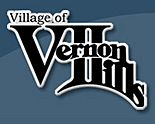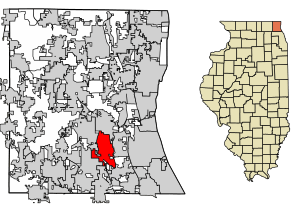Vernon Hills, Illinois facts for kids
Quick facts for kids
Vernon Hills
|
|
|---|---|
| The Village of Vernon Hills, Illinois | |

|
|
| Motto(s):
"People Planning With Pride"
|
|

Location of Vernon Hills in Lake County, Illinois.
|
|

Location of Illinois in the United States
|
|
| Country | United States |
| State | Illinois |
| County | Lake |
| Township | Libertyville, Vernon |
| Settled | 1851 |
| Incorporated as village | June 16, 1958 |
| Area | |
| • Total | 7.94 sq mi (20.58 km2) |
| • Land | 7.74 sq mi (20.05 km2) |
| • Water | 0.20 sq mi (0.53 km2) |
| Population
(2020)
|
|
| • Total | 26,850 |
| • Density | 3,468.54/sq mi (1,339.22/km2) |
| Time zone | UTC-6 (CST) |
| • Summer (DST) | UTC-5 (CDT) |
| ZIP Code(s) |
60061
|
| Area code(s) | 847 & 224 |
| FIPS code | 17-77694 |
| Per capita income: | $40,411 (2010) |
| Home value: | $352,300 (2010) |
Vernon Hills is a village located north of Chicago, Illinois. It is in Lake County, Illinois, in the United States. In 2020, about 26,850 people lived there. Vernon Hills is a major shopping area for nearby towns. These include Libertyville, Lake Forest, and Mundelein. Other towns are Long Grove, Lincolnshire, and Buffalo Grove.
Contents
- A Look Back at Vernon Hills' History
- Exploring Vernon Hills' Geography
- People and Community in Vernon Hills
- What's in Vernon Hills?
- Arts and Culture in Vernon Hills
- Parks and Fun in Vernon Hills
- Learning and Schools in Vernon Hills
- Getting Around Vernon Hills
- Famous People from Vernon Hills
- See also
A Look Back at Vernon Hills' History
The land that became Vernon Hills started as a 200-acre (0.81 km2) farm in 1857. Richard Theodore Freese, Ron Freese, Nathan Kowitt, and Jim Carswell helped found the area. Not much changed until the 1960s. Then, some land was bought for homes and a golf course. This was the first time the name "Vernon Hills" was used.
On June 16, 1958, Vernon Hills officially became a village. It had 123 residents and 125 houses. The village and police worked from a motel until 1971. That year, the village bought two portable buildings for offices.
Vernon Hills grew slowly but steadily. In 1971, more land was added near IL-60 and IL-21. This led to building the 1,200,000 sq ft (110,000 m2) Hawthorn Center. By 1980, the village's population grew to almost 10,000 people. By 2000, it had more than 20,000 residents.
During the 1980s and 1990s, the village grew by adding surrounding areas. This included land for the Corporate Woods business park in 1986. It also included the Centennial Crossing homes in 1986. A 1,200-acre (4.9 km2) part of Hawthorne-Mellody Farms was added in 1988. Part of the village of Half Day was added in 1994.
Exploring Vernon Hills' Geography
In 2010, Vernon Hills covered about 7.917 square miles (20.51 km2). Most of this area, about 7.71 square miles (19.97 km2), is land. The remaining 0.207 square miles (0.54 km2) is water.
Weather in Vernon Hills
Vernon Hills has a varied climate throughout the year.
| Climate data for Vernon Hills, Illinois | |||||||||||||
|---|---|---|---|---|---|---|---|---|---|---|---|---|---|
| Month | Jan | Feb | Mar | Apr | May | Jun | Jul | Aug | Sep | Oct | Nov | Dec | Year |
| Mean daily maximum °F (°C) | 32 (0) |
36 (2) |
45 (7) |
57 (14) |
68 (20) |
78 (26) |
83 (28) |
81 (27) |
74 (23) |
62 (17) |
49 (9) |
36 (2) |
58.416 (14.68) |
| Mean daily minimum °F (°C) | 16 (−9) |
19 (−7) |
28 (−2) |
38 (3) |
47 (8) |
57 (14) |
63 (17) |
62 (17) |
54 (12) |
42 (6) |
33 (1) |
20 (−7) |
36.916 (2.73) |
People and Community in Vernon Hills
The population of Vernon Hills has grown a lot over the years.
| Historical population | |||
|---|---|---|---|
| Census | Pop. | %± | |
| 1960 | 123 | — | |
| 1970 | 1,056 | 758.5% | |
| 1980 | 9,827 | 830.6% | |
| 1990 | 15,319 | 55.9% | |
| 2000 | 20,120 | 31.3% | |
| 2010 | 25,113 | 24.8% | |
| 2020 | 26,850 | 6.9% | |
| U.S. Decennial Census 2010 2020 |
|||
Who Lives in Vernon Hills?
In 2020, the village had 26,850 people. The population is made up of many different groups.
| Race / Ethnicity (NH = Non-Hispanic) | Pop 2000 | Pop 2010 | Pop 2020 | % 2000 | % 2010 | % 2020 |
|---|---|---|---|---|---|---|
| White alone (NH) | 15,691 | 16,434 | 15,039 | 77.99% | 65.44% | 56.01% |
| Black or African American alone (NH) | 336 | 527 | 635 | 1.67% | 2.10% | 2.36% |
| Native American or Alaska Native alone (NH) | 10 | 19 | 36 | 0.05% | 0.08% | 0.13% |
| Asian alone (NH) | 2,337 | 4,848 | 6,931 | 11.62% | 19.30% | 25.81% |
| Pacific Islander alone (NH) | 2 | 10 | 10 | 0.01% | 0.04% | 0.04% |
| Other race alone (NH) | 30 | 25 | 120 | 0.15% | 0.10% | 0.45% |
| Mixed race or Multiracial (NH) | 268 | 390 | 810 | 1.33% | 1.55% | 3.02% |
| Hispanic or Latino (any race) | 1,446 | 2,860 | 3,269 | 7.19% | 11.39% | 12.18% |
| Total | 20,120 | 25,113 | 26,850 | 100.00% | 100.00% | 100.00% |
In 2010, there were 20,120 people living in Vernon Hills. About 42.3% of households had children under 18. Most households (59.2%) were married couples. The average household had 2.66 people. The average family had 3.24 people.
The median age in the village was 34 years old. About 29.2% of the population was under 18. About 6.1% were 65 or older.
What's in Vernon Hills?
Vernon Hills is home to many important companies. These businesses provide jobs and products for people everywhere.
- American Optical Company: They design and make fancy glasses.
- CDW: This company provides technology products and services. They help businesses, governments, and schools.
- Zebra Technologies: They make printers for barcodes and receipts. Over 90% of big companies use their products.
- American Hotel Register Company: They make and supply products for hotels.
- Rust-Oleum Corporation: This company makes paints and coatings. They are used for homes and industries around the world.
- Elorac, Inc.: This is a special medicine company. They focus on new skin treatments.
- Cole-Parmer: They distribute scientific and industrial tools.
Recently, Vernon Hills built a new shopping center called Mellody Farm. It used to be a soybean field. Now it has many restaurants and stores.
Top Employers in Vernon Hills
Here are some of the biggest employers in Vernon Hills:
| # | Employer | # of Employees |
|---|---|---|
| 1 | Hawthorn Mall | 2,500 |
| 2 | American Hotel Register (HQ) | 500 |
| 3 | Mitsubishi Electric Automation | 400 |
| 4 | CDW (HQ) | 350 |
| 4 | Rust-Oleum (HQ) | 350 |
| 6 | ZF Aftermarket | 300 |
| 6 | Cole-Parmer (HQ) | 300 |
| 6 | Becton Dickinson | 300 |
| 9 | Richard Wolf Medical Instruments Corp. | 200 |
| 10 | Neil Enterprises | 160 |
Arts and Culture in Vernon Hills
Vernon Hills is part of the Cook Memorial Public Library District. The new Aspen Drive Library opened on July 10, 2010. This 20,000 sq ft (1,900 m2) building is across from the Vernon Hills Elementary and Grade School Campus. It is located at 701 N Aspen Drive.
The Aspen Drive Library is the first full-service library in the village. It has 120,000 books, movies, and music. The library also has a fun children's area. There is a high-tech area for teens. It also has a computer lab and study rooms.
Other parts of Vernon Hills are in the Vernon Area Public Library District.
Parks and Fun in Vernon Hills
In 2000, the village bought land that used to be a military base. It was a Nike missile base for the U.S. Army. It was also a training center for the U.S. Navy. Later, it belonged to the Curtiss Candy Company. This land was turned into the 184-acre (0.74 km2) Vernon Hills Athletic Complex (VHAC). This complex offers many sports and activities.
Learning and Schools in Vernon Hills
There are six elementary and middle schools in Vernon Hills. They are part of the Hawthorn School District. In 2006, Hawthorn Junior High School split into two schools. They became Hawthorn Middle School North and Hawthorn Middle School South.
High school students used to go to Libertyville High School. Since 2000–2001, they now attend either Vernon Hills High School or Libertyville High School.
Some students in the southwest part of Vernon Hills go to Long Grove schools. These include Country Meadows and Woodlawn. Some areas in southern Vernon Hills send students to Lincolnshire schools. This includes Adlai E. Stevenson High School. A small part of the village in the southwest goes to high school in Mundelein, IL.
Elementary students can go to four different Hawthorn Schools:
- Hawthorn Elementary South
- Hawthorn Elementary North
- Aspen Elementary
- Townline Elementary
A new Kindergarten Building is being built. It is expected to be ready by the 2021 school year.
Getting Around Vernon Hills
Vernon Hills has a train station. It is on Metra's North Central Service line. This train provides daily service between Antioch, Illinois and Chicago, Illinois (at Union Station). Pace buses also serve the village.
Famous People from Vernon Hills
Many well-known people have lived in Vernon Hills.
- Sam Acho, football player
- Alex Brown, football player
- Jermon Bushrod, football player
- Desmond Clark, football player
- Tarik Cohen, football player
- Jay Cutler, football player
- DaVaris Daniels, football player
- Phillip Daniels, football player and coach
- David Dobrik, YouTuber
- Steve Dubinsky, hockey player
- Leonard Floyd, football player
- Robert P. Hanrahan, politician
- Devin Hester, football player
- Christopher Howarth, figure skater
- Kathleen A. Ryg, politician
- Cairo Santos, football player
- Carol Sente, politician
- Nicole Sladkov, rhythmic gymnast
- Evan Spencer, football player
- Tim Spencer, football player and coach
- Nathan Vasher, football player
- Kevin Walter, football player
- Cody Whitehair, football player
See also
 In Spanish: Vernon Hills (Illinois) para niños
In Spanish: Vernon Hills (Illinois) para niños

